Lichen: Difference between revisions
No edit summary |
No edit summary |
||
| Line 10: | Line 10: | ||
Lichen occur in one of four growth forms. These include crustose, squamulose, foliose, and fruticose. (5) | Lichen occur in one of four growth forms. These include crustose, squamulose, foliose, and fruticose. (5) | ||
[[File:Lichen types.jpg|center|400px|]] | [[File:Lichen types.jpg|center|400px|]] | ||
''Crustose'' lichen are lichen that are pressed against their substrate. They form a crust over their substrate. (6) Their medulla is in direct contact with the substrate it is growing on. (7) | |||
''Squamulose'' lichen are | |||
| Line 45: | Line 49: | ||
[5] http://www.ucmp.berkeley.edu/fungi/lichens/lichenmm.html | [5] http://www.ucmp.berkeley.edu/fungi/lichens/lichenmm.html | ||
[6] https://www.fs.fed.us/wildflowers/beauty/lichens/biology/growthforms.shtml | |||
[7] http://www.lichens.lastdragon.org/faq/lichenthallustypes.html | |||
Revision as of 15:37, 10 May 2018
Lichen is a compound organism, made up of two species. A fungus and a cyanobacteria or green algae live symbiotically, and both are benefited from this mutualistic relationship. In exchange for a safe habitat to live in, the cyanobacteria or green algae provide food to the fungus from their photosynthetic processes. (1) The body of a lichen is a thallus, or a plant body that is not differentiated into stems and leaves, and lacks roots and a vascular system.
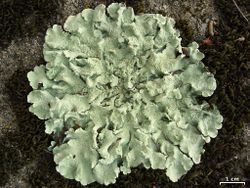
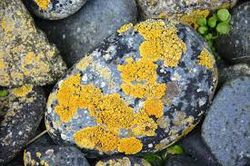
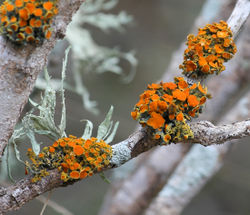
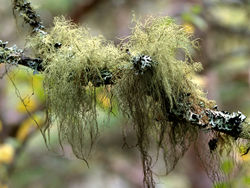
Types of Lichen
Lichen occur in one of four growth forms. These include crustose, squamulose, foliose, and fruticose. (5)
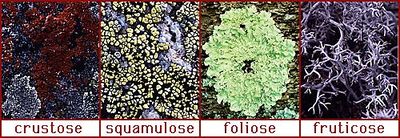
Crustose lichen are lichen that are pressed against their substrate. They form a crust over their substrate. (6) Their medulla is in direct contact with the substrate it is growing on. (7)
Squamulose lichen are
Biology
Unlike plants, lichen do not have a vascular system. This means they do not have a xylem or phloem to move nutrients and water around their plant body. Lichen get their water and nutrients by absorbing them from their surroundings. (3)
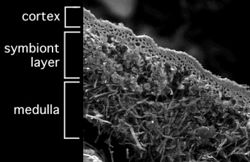
Cortex
The outer layer of the lichen is called the cortex. The cells in the cortex are thicker and more closely packed, providing a small amount of protection for the organism. (3)
Medulla
Fungal filaments, or medulla, make up most of the lichen organism. Fungal cells are loosely packed in the middle of the lichen body, with thin cell walls and a threadlike structure. (3)
Attachments
Rhizines
Some lichen use rhizines to attach to their substrate. Rhizines are fungal filaments extending out from the medulla. Rhizines do not move water or help the lichen breathe. Their sole purpose is stabilizing the lichen down. (3)
Holdfast
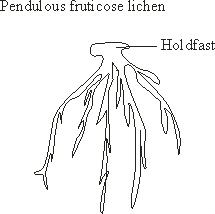
Some lichen use holdfasts to fasten themselves down. This is a central peg that extends out from the lichen thallus. (3)
Ecology
Lichen play a huge role in the development of ecosystems, and also a huge role in established ecosystems. They play an important role in the water cycle in forests, greatly increasing the interception and absorption of precipitation. (4) Lichen are able to sequester limiting nutrients from the atmosphere, and these in turn become available to other organisms when lichen die, fall, and decompose, or through leachate. (4) The presence of lichen also provides increased habitat complexity for small organisms. There is a close relationship between lichen and invertebrates, including Arachnids such as orabitid mites, insects, rotifers, tardigrades, and spiders. (4) Providing habitat for these micro organisms is the base of the food chain, and provides food sources for the rest of the food web.
Pioneer Species
Lichen are considered pioneer species, or the first organism to appear in areas of primary succession. (2) They are able to colonize bare rocks, and an ecosystem is then able to begin developing on them.
Indication
An indicator species is a species that tells something about the environment by their presence, or absence, in that environment. Lichens are indicators of environmental pollution. They have no way to detoxify and excrete harmful chemicals from the air, so absence of lichen in an ecosystem can be an indicator of environmental stress due to pollution. (1)
References
[1] Lewis, Ricki. "Lichen." Biology, edited by Melissa Sue Hill, 2nd 2d., vol. 3, Macmillan Reference USA, 2016, pp 12-13. Science in Context
[2] Discovery Education Science, Primary and Secondary Succession
[3] “Lichen Biology.” Lichen Biology - Structure, www.fs.fed.us/wildflowers/beauty/lichens/biology/index.shtml.
[4] Ellis, Christopher J. “Lichen Epiphyte Diversity: A Species, Community and Trait-Based Review.” Perspectives in Plant Ecology, Evolution and Systematics, vol. 14, no. 2, 2012, pp. 131–152., doi:10.1016/j.ppees.2011.10.001.
[5] http://www.ucmp.berkeley.edu/fungi/lichens/lichenmm.html
[6] https://www.fs.fed.us/wildflowers/beauty/lichens/biology/growthforms.shtml
[7] http://www.lichens.lastdragon.org/faq/lichenthallustypes.html